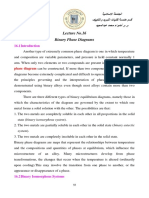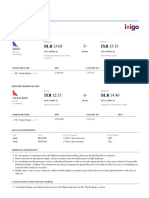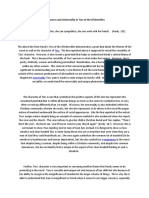Hydrate Prediction Based On Composition For Sweet Gases: Fig. 20-19 Through 20-21
Hydrate Prediction Based On Composition For Sweet Gases: Fig. 20-19 Through 20-21
Uploaded by
TAHIR MAHMOODCopyright:
Available Formats
Hydrate Prediction Based On Composition For Sweet Gases: Fig. 20-19 Through 20-21
Hydrate Prediction Based On Composition For Sweet Gases: Fig. 20-19 Through 20-21
Uploaded by
TAHIR MAHMOODOriginal Title
Copyright
Available Formats
Share this document
Did you find this document useful?
Is this content inappropriate?
Copyright:
Available Formats
Hydrate Prediction Based On Composition For Sweet Gases: Fig. 20-19 Through 20-21
Hydrate Prediction Based On Composition For Sweet Gases: Fig. 20-19 Through 20-21
Uploaded by
TAHIR MAHMOODCopyright:
Available Formats
be expanded to atmospheric pressure without hydrate forma- Nitrogen is assumed to be a non-hydrate former and is also
tion. assigned a K-value of infinity.
Conditions predicted by Fig. 20-19 through 20-21 may be sig- The Kvs values are used in a “dewpoint” equation to deter-
nificantly in error for compositions other than those used to derive mine the hydrate temperature or pressure. The calculation is
the charts. For more accurate determination of hydrate formation iterative and convergence is achieved when the following ob-
conditions, the following procedures should be followed. In addi- jective function (Eq 20-4) is satisfied.
tion, Fig. 20-20 and 20-21 do not account for liquid water and liquid i=n
∑ (yi / Kvs )
hydrocarbons present or formed during the expansion. These can
= 1.0 Eq 20-4
have a significant effect on the outlet temperature from the pres-
sure reduction device. i=1
Hydrate Prediction Based on Composition Prudence should be exercised when some higher molecular
for Sweet Gases weight isoparaffins and certain cycloalkanes are present as
Several correlations have proven useful for predicting hy- they can form Structure H hydrates.
drate formation of sweet gases and gases containing minimal Example 20-7 — Calculate the pressure for hydrate
amounts of CO2 and/or H2S. The most reliable ones require a formation at 50°F for a gas with the following composition.
gas analysis. The Katz method14,15 utilizes vapor solid equilib-
Mole at 300 psi at 400 psi
rium constants defined by the Eq 20-3. Component Fraction
y in Gas Kvs y/Kvs Kvs y/Kvs
Kvs = Eq 20-3
xs Methane 0.784 2.04 0.384 1.75 0.448
Ethane 0.060 0.79 0.076 0.50 0.120
WARNING: Not good for pure components – only mixtures.
Propane 0.036 0.113 0.319 0.072 0.500
The applicable K-value correlations for the hydrate forming
Isobutane 0.005 0.046 0.109 0.027 0.185
molecules (methane, ethane, propane, isobutane16, normal bu-
tane17, carbon dioxide, and hydrogen sulfide) are shown in Fig. n-Butane 0.019 0.21 0.090 0.21 0.090
20-23 to 20-29. Normal butane cannot form a hydrate by itself Nitrogen 0.094 * 0.000 * 0.000
but can contribute to hydrate formation in a mixture. Carbon dioxide 0.002 3.0 0.001 1.9 0.001
For calculation purposes, all molecules too large to form hy- Total 1.000 0.979 1.344
drates have a K-value of infinity. These include all normal par- * Infinity Interpolating linearly, Σy/Kvs = 1.0 at 305 psia
affin hydrocarbon molecules larger than normal butane.
FIG. 20-19
FIG. 20-18
Pressure-Temperature Curves for
Conditions for Hydrate Formation for Light Gases Predicting Hydrate Formation
20-13
You might also like
- GPSA - Engineering Data Book, 12ed 1Document1 pageGPSA - Engineering Data Book, 12ed 1TAHIR MAHMOODNo ratings yet
- H2 Liquefaction - Cryogenic V14 - HYSYS (Aspentech)Document9 pagesH2 Liquefaction - Cryogenic V14 - HYSYS (Aspentech)Ian MannNo ratings yet
- Liquid Viscosity Correlations GilmontDocument6 pagesLiquid Viscosity Correlations Gilmontk64515No ratings yet
- Lab Report 4Document10 pagesLab Report 4sagarchawlaNo ratings yet
- Considerando El Futuro de La ProfesionDocument52 pagesConsiderando El Futuro de La ProfesionTania BeltranNo ratings yet
- Ricoh SP 9100 Services ManualDocument866 pagesRicoh SP 9100 Services ManualWaqar Ak50% (2)
- Graficos de Deshidratacion Del GNDocument57 pagesGraficos de Deshidratacion Del GNCesar Alvarez100% (1)
- Lecture#DehydrationDocument87 pagesLecture#Dehydrationamirhasani885No ratings yet
- Short Communication A Modified Huron-Vidal Mixing Rule For Cubic Equations of StateDocument7 pagesShort Communication A Modified Huron-Vidal Mixing Rule For Cubic Equations of StateAllan PaoloNo ratings yet
- Esercizi Tipo Esame 13-01-2022Document15 pagesEsercizi Tipo Esame 13-01-2022armanjeffryNo ratings yet
- Capacities of Real Mixtures of Real: Heat Gases GasesDocument6 pagesCapacities of Real Mixtures of Real: Heat Gases GasesAntonioNo ratings yet
- D. Presnell - Phase Diagrams of Earth-Forming Minerals (Short Article) (1995)Document21 pagesD. Presnell - Phase Diagrams of Earth-Forming Minerals (Short Article) (1995)lina jimenezNo ratings yet
- OSP 050 Berechnungen Hydrospeicher en LowDocument5 pagesOSP 050 Berechnungen Hydrospeicher en LowLucian TudorNo ratings yet
- PVT HW - Helalizadeh PDFDocument4 pagesPVT HW - Helalizadeh PDFMohama KarimiNo ratings yet
- Evaporation of Crude Oil at Sea: Water ResDocument7 pagesEvaporation of Crude Oil at Sea: Water ResLAURA LUC�A ATENCIA CASTILLONo ratings yet
- PRSV: An Improved Peng-Robinson Equation of State For Pure Compounds and MixturesDocument11 pagesPRSV: An Improved Peng-Robinson Equation of State For Pure Compounds and MixturesFSBoll100% (1)
- Phase Equilibria in Condensed SystemsDocument26 pagesPhase Equilibria in Condensed SystemsFabian Andres Calderon HurtadoNo ratings yet
- Ecuación FullerDocument1 pageEcuación FullerKarla DelgadoNo ratings yet
- CHE 2202 Module1 - Evaluation of Enthalpy Diference Part 1 - StudentDocument18 pagesCHE 2202 Module1 - Evaluation of Enthalpy Diference Part 1 - StudentKing Antonio AbellaNo ratings yet
- Seader Chapter 2 Problem SetDocument6 pagesSeader Chapter 2 Problem SetilvisoctavioNo ratings yet
- GFDocument8 pagesGFManish KumarNo ratings yet
- Temperatures Charts (Heisler Charts) : The Biot Number and Fourier NumberDocument12 pagesTemperatures Charts (Heisler Charts) : The Biot Number and Fourier NumberAhmed Shaaban Soliman HamedNo ratings yet
- Gucker, JR., PittsDocument10 pagesGucker, JR., PittsMarie GoeppNo ratings yet
- Estimation of Heats of Formation of Organic Compounds: ( (HT" (HT'Document8 pagesEstimation of Heats of Formation of Organic Compounds: ( (HT" (HT'Putri Nadya KamilaNo ratings yet
- Gas Hydrates of Carbon Dioxide-Methane Mixtures - Carl H UnhruhDocument4 pagesGas Hydrates of Carbon Dioxide-Methane Mixtures - Carl H UnhruhAarya PatelNo ratings yet
- DMCB 2423 - Tutorial CHPT 9 - AnswerDocument6 pagesDMCB 2423 - Tutorial CHPT 9 - Answerzul hilmiNo ratings yet
- Chemical Energies and Exergies of Fuels - V. S. Stepanov (Pergamon - 1995)Document8 pagesChemical Energies and Exergies of Fuels - V. S. Stepanov (Pergamon - 1995)Harold Valle ReyesNo ratings yet
- Uyfrbfhrb 10Document11 pagesUyfrbfhrb 10Bill644No ratings yet
- M25 GpsaDocument24 pagesM25 GpsaPawan ChaturvediNo ratings yet
- Chemical EngineersDocument37 pagesChemical Engineersjessejames.supangNo ratings yet
- ReportDocument6 pagesReportRodrigoSantannaNo ratings yet
- EMat106 Lec 3 Updated VersionDocument34 pagesEMat106 Lec 3 Updated VersionmayNo ratings yet
- 1983 Fire Tech Pool FiresDocument12 pages1983 Fire Tech Pool FiresJuan PulgarNo ratings yet
- The Model: A UNIFAC-Based Equation of State Model For Prediction of Gas Solubility and Vapor-Liquid Equilibria at Low and High PressuresDocument10 pagesThe Model: A UNIFAC-Based Equation of State Model For Prediction of Gas Solubility and Vapor-Liquid Equilibria at Low and High PressuresFlor de LeonNo ratings yet
- 104 PhaseDiags QS2AnsDocument6 pages104 PhaseDiags QS2Ansnilanga123No ratings yet
- Ex 2Document6 pagesEx 2wsanchez_soteloNo ratings yet
- Acs Energyfuels 6b00491Document9 pagesAcs Energyfuels 6b00491TimelessNo ratings yet
- Chemical Thermodynamics: by Jorge Omar Gil Posada CH9: An Introduction To MixturesDocument77 pagesChemical Thermodynamics: by Jorge Omar Gil Posada CH9: An Introduction To MixturesCarolina FernandezNo ratings yet
- nederbragt1949Document12 pagesnederbragt1949Roberto SilvaNo ratings yet
- Eact-R Little: The Structure Entropy Ice and Other Crystals Atomic ArrangementDocument5 pagesEact-R Little: The Structure Entropy Ice and Other Crystals Atomic ArrangementSandy emulatorNo ratings yet
- 16 970396970Document15 pages16 970396970valeska reinosoNo ratings yet
- 1983 Fire Tech Pool FiresDocument12 pages1983 Fire Tech Pool FiresTorero02No ratings yet
- A Self-Consistent GE MR For CEoS Derivation and Fugacity CoefficientsDocument4 pagesA Self-Consistent GE MR For CEoS Derivation and Fugacity Coefficientsmurdanetap957No ratings yet
- Gráficos de Deshidratacion Del GNDocument57 pagesGráficos de Deshidratacion Del GNAlbert Torrez RiveroNo ratings yet
- Chemical Engineering 120 - Separation Processes: Homework #1. Due: Friday, 12 April 2002Document2 pagesChemical Engineering 120 - Separation Processes: Homework #1. Due: Friday, 12 April 2002Sata AjjamNo ratings yet
- Tutorial 2Document2 pagesTutorial 2ayushNo ratings yet
- (Holzapfel) Linear Isotherm Regularities of Solid Sodium Under Pressure, AIP2020Document9 pages(Holzapfel) Linear Isotherm Regularities of Solid Sodium Under Pressure, AIP2020tinhvan01No ratings yet
- Chemical Engineering 301 Lecture Notes: (Revised 9/04)Document9 pagesChemical Engineering 301 Lecture Notes: (Revised 9/04)shiv kr dubeyNo ratings yet
- Thermo LL - PalangDocument89 pagesThermo LL - PalangMond KhajornsakwongwaiNo ratings yet
- B. Real GasesDocument57 pagesB. Real GasesRayanna WardNo ratings yet
- Calculations in Natural Gas CourseDocument6 pagesCalculations in Natural Gas CourseVijay KumarNo ratings yet
- Homework 2 Due: Thursday, February 7, 2019 in Class: PNG 410 Applied Reservoir EngineeringDocument5 pagesHomework 2 Due: Thursday, February 7, 2019 in Class: PNG 410 Applied Reservoir EngineeringMuStafaAbbasNo ratings yet
- Drip Feed CarburizingDocument8 pagesDrip Feed Carburizingxiao mingNo ratings yet
- DR - Khaled Lecture ProblemsDocument45 pagesDR - Khaled Lecture ProblemsMHT allamNo ratings yet
- Effect of On Equation-of-State Predictions: C Prop ErtiesDocument12 pagesEffect of On Equation-of-State Predictions: C Prop ErtiesAllanNo ratings yet
- AspenHYSYSV7 Hydrate Formation Utility PDFDocument16 pagesAspenHYSYSV7 Hydrate Formation Utility PDFAndrés Daniel GotopoNo ratings yet
- Exercise 6: Dew Point and Bubble Point Calculation: Assignment 1Document2 pagesExercise 6: Dew Point and Bubble Point Calculation: Assignment 1Junaid0% (1)
- 1997 J. Sol. Chem., Alcohol FreezingDocument13 pages1997 J. Sol. Chem., Alcohol Freezingcalli fioreNo ratings yet
- Prediction Azeotropism and Calculation Azeotropic: of DataDocument8 pagesPrediction Azeotropism and Calculation Azeotropic: of DataEnrique Soto MercaderNo ratings yet
- Phys and Colloid Project BKDocument4 pagesPhys and Colloid Project BKAlliana PaduhilaoNo ratings yet
- A Modern Course in Statistical PhysicsFrom EverandA Modern Course in Statistical PhysicsRating: 3.5 out of 5 stars3.5/5 (2)
- Gas Hydrates 1: Fundamentals, Characterization and ModelingFrom EverandGas Hydrates 1: Fundamentals, Characterization and ModelingDaniel BrosetaNo ratings yet
- Part PR Requirements For Boilers Fabricated by Riveting - . - . - . - . - . - . .Document1 pagePart PR Requirements For Boilers Fabricated by Riveting - . - . - . - . - . - . .TAHIR MAHMOODNo ratings yet
- Bar Angles: Also Available GalvanizedDocument1 pageBar Angles: Also Available GalvanizedTAHIR MAHMOODNo ratings yet
- Celebrating Over 50 Years of Service!Document1 pageCelebrating Over 50 Years of Service!TAHIR MAHMOODNo ratings yet
- Dehydration: Section 20Document1 pageDehydration: Section 20TAHIR MAHMOODNo ratings yet
- 2Document1 page2TAHIR MAHMOODNo ratings yet
- Foreword: EN ISO 15611:2003 (E)Document1 pageForeword: EN ISO 15611:2003 (E)TAHIR MAHMOODNo ratings yet
- En Iso 15611:2003 (E)Document1 pageEn Iso 15611:2003 (E)TAHIR MAHMOODNo ratings yet
- 1 Scope: EN ISO 15611:2003 (E)Document1 page1 Scope: EN ISO 15611:2003 (E)TAHIR MAHMOODNo ratings yet
- Cap FactorsDocument1 pageCap FactorsTAHIR MAHMOODNo ratings yet
- 3Document1 page3TAHIR MAHMOODNo ratings yet
- Rectangular Flange DesignDocument6 pagesRectangular Flange DesignTAHIR MAHMOODNo ratings yet
- AS/NZS/ISO 817 and AS/NZS5149.1-4 Refrigeration ImpactsDocument1 pageAS/NZS/ISO 817 and AS/NZS5149.1-4 Refrigeration ImpactsTAHIR MAHMOODNo ratings yet
- Refrigeration Standards Update: Safety and Environmental RequirementsDocument1 pageRefrigeration Standards Update: Safety and Environmental RequirementsTAHIR MAHMOODNo ratings yet
- Electric Spring Return Actuators: SeriesDocument1 pageElectric Spring Return Actuators: SeriesTAHIR MAHMOODNo ratings yet
- FTU-200 Catalog (P200, R200, P200C, R200C) PDFDocument17 pagesFTU-200 Catalog (P200, R200, P200C, R200C) PDFHung Cuong PhamNo ratings yet
- 4.1.1 The Pig Pen Cipher 247KBDocument2 pages4.1.1 The Pig Pen Cipher 247KBAkula MallikarjunaNo ratings yet
- Allcargo Logistics Park Pvt. Ltd. ICD Dadri,: Network of CFS and ICD Facilities of ALL CARGO LOGISTICSDocument2 pagesAllcargo Logistics Park Pvt. Ltd. ICD Dadri,: Network of CFS and ICD Facilities of ALL CARGO LOGISTICSVignesh_Kumar_7522No ratings yet
- SAP PM Transaction Codes List (Plant Maintenance)Document3 pagesSAP PM Transaction Codes List (Plant Maintenance)atu1981100% (3)
- POM Module 1Document59 pagesPOM Module 1suryadattabulle2001No ratings yet
- TicketofindianolanDocument2 pagesTicketofindianolanyashar khanNo ratings yet
- Section Iii Organization and Management StudyDocument6 pagesSection Iii Organization and Management StudyOres LegazpiNo ratings yet
- Princess Cruise Service Partner OA 6.21.21 PDFDocument8 pagesPrincess Cruise Service Partner OA 6.21.21 PDFJose Anibal PeñaNo ratings yet
- Precor 9.27 ServiceManualDocument58 pagesPrecor 9.27 ServiceManualAdrian Garcia FrancoNo ratings yet
- Presentasi-Espring in IDDocument55 pagesPresentasi-Espring in IDPurnama HadiNo ratings yet
- Housekeeping NC II CG-2Document19 pagesHousekeeping NC II CG-2Lerwin Garinga100% (2)
- Psycholinguistics: Speech ProductionDocument15 pagesPsycholinguistics: Speech Productionvlahoti14No ratings yet
- Asfiya Portion PaperDocument2 pagesAsfiya Portion PaperMohamed SoudhNo ratings yet
- Nuclear Engineering and Technology: Original ArticleDocument9 pagesNuclear Engineering and Technology: Original ArticleDiogo CoelhoNo ratings yet
- Cosmic Conversations TimeSpace-A4Document18 pagesCosmic Conversations TimeSpace-A4kostaNo ratings yet
- Dissertation Extension NorthumbriaDocument6 pagesDissertation Extension NorthumbriaWhatIsTheBestPaperWritingServiceOverlandPark100% (1)
- Liao 2004Document14 pagesLiao 2004graynaNo ratings yet
- Lesson 2: First Steps To UnderstandingDocument12 pagesLesson 2: First Steps To UnderstandingAbdur RahmanNo ratings yet
- Preservation of Photographic Material GuideDocument10 pagesPreservation of Photographic Material GuideSARAI ELI LANDA ROJASNo ratings yet
- Superstrut Metal FramingDocument83 pagesSuperstrut Metal FramingAdam SonNo ratings yet
- Hareem Khan & Asad Muhammad: Presented To: Ma'am Sonia SalmanDocument20 pagesHareem Khan & Asad Muhammad: Presented To: Ma'am Sonia SalmanKumail ZaidiNo ratings yet
- Uputstvo V10b-EngDocument4 pagesUputstvo V10b-Engapi-299829164No ratings yet
- Risk Management in Construction: Syed M. Ahmed, PH.DDocument20 pagesRisk Management in Construction: Syed M. Ahmed, PH.DSufian AhmadNo ratings yet
- 1 1mm 2 2mm 3 3mm 4 4mm 5 5mm 6 6mm 7 8mm 8 10mm 9 12mm 10 15mm 11 20mm 12 25mmDocument22 pages1 1mm 2 2mm 3 3mm 4 4mm 5 5mm 6 6mm 7 8mm 8 10mm 9 12mm 10 15mm 11 20mm 12 25mmJagdish GhogareNo ratings yet
- Chapter 2Document12 pagesChapter 2Al7asanAmmarNo ratings yet
- Physics-Informed Deep Learning - A Promising Technique For System Reliability AssessmentDocument29 pagesPhysics-Informed Deep Learning - A Promising Technique For System Reliability AssessmentPeter PhamNo ratings yet
- Conflict Management: EDPS Flagship Course On Academic Excellence January 20, 2014Document86 pagesConflict Management: EDPS Flagship Course On Academic Excellence January 20, 2014russ napud100% (1)
- Uniqueness and Universality in Tess of The D'UbervillesDocument2 pagesUniqueness and Universality in Tess of The D'UbervillesaliNo ratings yet








































































































